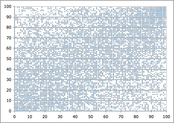In this article, the author explains a new method being used that allegedly makes the use of VAM more reliable and valid than ever before.
As a brief background summary: VAM is a method whereby statistical analysis of standardized tests is used in combination with demographic backgrounds of students and teachers in order to calculate how much a teacher should improve a student's ability vs. how much they a actually do. I have found this method very tenuous ever since reading Gary Rubenstein's critique of it back in 2012.

The top comment on this article comes from a gentleman named BIll Honig, who accurately states (and cites):
Studies have shown that under current tests, a teacher who tests rank her at the 50th percentile could be anywhere from the 85th percentile to the 15th A significant number of teachers bounce from top to bottom or vice versa from year to year. (Reseach cited below) A recent report from the Federal Department of Education (of all places) found very high misidentifications even with three years of data per teacher. One fourth of teachers identified as needing special treatment were actually at the mid-range of performance and one-fourth of teachers who were deemed as average were actually in need of special treatment. http://ies.ed.gov/ncee/pubs/20104004/pdf/20104004.pdf


 RSS Feed
RSS Feed
